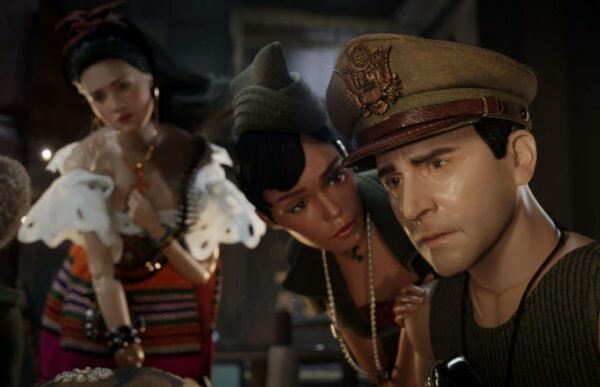Review: Welcome to Marwen


The story of Mark Hogencamp is nothing short of horrific. In April of 2000, the artist was beaten within an inch of his life after his five attackers learned that he was a cross-dresser. He slipped into a coma for 9 days and after a 40-day hospital stay, Hogencamp was left with significant brain damage, irreparable memory loss, PTSD, and an inability to get the necessary therapy to deal with it all. He eventually turned to art as a coping mechanism, constructing a ⅙th model of a fictional WWII-era Belgian town called Marwencol. The town not only became the subject of Hogencamp’s famed photography, but a mental sojourn of sorts where he could imagine himself a brave soldier, ready for anything. It also became the inspiration for the Robert Zemeckis film, Welcome to Marwen.
If the film succeeds at one thing, it manages to immerse the audience in the same fantasy world where Hogencamp (played by Steve Carell) found so much comfort. Aesthetically, Marwen is an amusing flight of whimsy and a sometimes delightful break from the trauma that inspired it. It’s hard to resist the charm of these tough, gun-slinging dolls – all women, sans the Hogencamp doll-pelganger – as they fiercely protect the town that seems to be under sustained attack. It’s not long before you recognize that Marwen is a working metaphor for Mark himself, who is constantly revisited by his trauma. The imagery is fun (especially in the way the typical gore of losing body parts is replaced with doll parts simply popping off in childish fashion), and excels as an example of what is possible when you move beyond a person’s tragedy and focus on what makes them feel whole. There’s an astounding amount of beauty there, and it’s easy to fall in love with the potential.
With that said, if you try to delve beyond the fun, you’re not left with much else. As Marwen’s Hogencamp will tell you himself, the women of Marwen are supposed to be the soul of the town, the most vital component in both his and the fictional community’s survival. But the women in his life – who individually inspire each of the dollish protectors – are reduced to caricatures as plastic as their toy counterparts. They are props in every sense, which is especially disheartening when you consider how often they are subjected to kinda gross, sexist stunts.
And that’s what makes the overall Marwen experiences so confusing: the love that the film professes for these women and how it actually treats women are at direct odds with each other. An innocent doll is fridged mere minutes upon her arrival (we can’t even catch a break when we’re made of plastic!), one is held as a topless captive for laughs, and the newest arrival Nicol (Leslie Mann) is oddly framed negatively for not returning Hogencamp’s whirlwind affection. Mind you, this is after she smiles in the face of some creepy overtones as he explains to her her role in Marwen. None of this stops doll Hogencamp – Captain Hogie, as he is called – from grunting out a passionate, not-even-a-little-bit-subtle reminder that women are the saviors of the world. And considering everything that precedes it, that declaration rings totally disingenuous.
Even the more understated digs stand out here – namely when Hogencamp mentions that his favorite actress is an adult film star, which is unnecessarily played for laughs instead of just existing as…oh, I don’t know…a totally legitimate preference. And while some may feel inclined to argue that we should be forgiving of the more troubling aspects as they’re likely representative of a real man’s perspective, we should remember that these women are real, too. Well, real enough – the relationships depicted in the film were exaggerated in lieu of a more interesting Hollywood story. But most of them did exist in some fashion and, at least within the context of this story, they are heralded as the ones who saved Hogencamp’s life. That alone makes them worthy of respectful, fleshed out material.
So without the depth you’re left with a cast simply trying their best. Carell manages to capture Hogencamp’s crushing vulnerability enough to kind of compensate for the more hokey dialogue from his doll avatar. Janelle Monae, Gwendoline Christie, and Eiza Gonzalez breathe as much life into G.I. Julie, Anna, and Caralala as they can (by the way, I can’t be the only one who found Christie’s Russian accent perplexing). Per usual, Merritt Wever is a total standout as the caring hobby shopkeeper and doting friend, Roberta. She injects a brand of humor that feels like a bit of a gift to offset the fact that she mainly exists as a love interest instead of a fully realized person. Aside from Carell, the men are rightfully unremarkable vehicles of cruelty, which is probably more representative of Hogencamp’s experience than anything else.
Still, what resonates above all else – even beyond the interesting visuals and cinematography – is all the lost potential. Here was an opportunity to show the great possibilities that lie with a chosen family, the healing power of women, or even a deep exploration of art as an alternative method of healing. Instead, we’re given something akin to a childish romp with toys. It’s…cute at times, but it doesn’t quite feel like the story that Hogencamp or his protectors deserve.
Welcome to Marwen premieres in theaters December 21.
